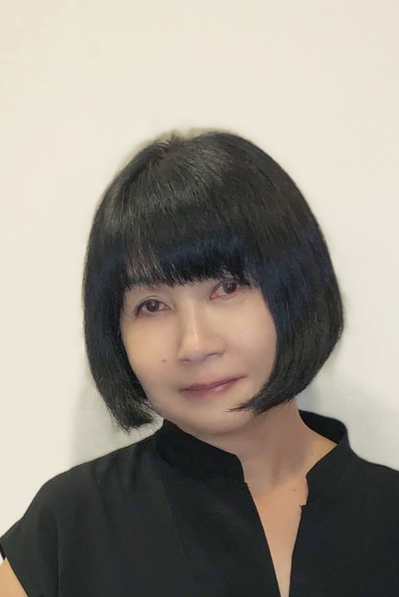
Junko Ito
Born in Aichi Prefecture, Japan, Junko is an editor and translator of the Korean language. She visited South Korea in 1990 and now runs a translation and editing agency. In 2017, she launched 『中くらいの友だち——韓くに手帖』, a magazine dedicated to discussing, savoring and enjoying South Korea. She is the author of『韓国 現地からの報告』,『韓国カルチャー』,『続・韓国カルチャー 描かれた「歴史」と社会の変化』and the translator of『搾取都市、ソウル』by Hyemi Lee. She also wrote commentary for the Japanese translation of Kim Jiyoung, Born 1982 by Cho Nam-joo.
Korean dramas and movies, which have gained popularity globally, often feature scenes of meals, which stimulate the viewers’ appetite. If you search online for “Korean drama meals,” you can easily find recipes to recreate meals that have appeared in popular dramas. Many books have been published on this subject. We also see that people are flocking to Koreatowns around the world and paying a visit to South Korea in search of authentic gourmet meals.
Why do Korean dramas and movies often feature dining scenes? We can find part of the answer in 『続・韓国カルチャー 描かれた「歴史」と社会の変化』written by Junko Ito. Her book examines social changes through entertainment in South Korea and provides detailed explanations of the significance behind the meals depicted in popular dramas and films. Junko has authored numerous books on South Korea and has been introducing Korean culture to Japan for many years. We spoke to her about food culture and history in South Korea, delving into topics ranging from the increasing trend of solo dining and travel in recent years to the perspectives of the Korean diaspora communities.
Exploring the exquisite way of eating and living
--When I watch videos and films from South Korea, I come across many scenes of people eating food. It gives me the impression that people turn to food, whether they are feeling sad or happy. Is eating considered important in any situations in their daily life?
Junko Ito: For South Koreans, hunger is an extremely unfortunate condition, and eating is considered very important. For example, at work, it is customary to ask, “Have you eaten?” It is a form of greeting, but if you have not eaten, you are instantly invited to eat, no matter how busy you are. This is due to the history that it took a long time before people were able to eat good food. The Korean War destroyed the country and South Korea was one of the poorest countries in the world in 1960, where the economy was said to be worse than that of North Korea at that time.
--When I think of Korean food, I envision people eating namul or small plates of food together. On the other hand, in Japan, eating alone is called “solo katsu (solo activity),” and is attracting a lot of attention. Are there any preconceptions about eating alone in Korea?
Junko: In South Korea, the Japanese dramas Solitary Gourmet and Late Night Diner were big hits from 2000 to 2010, inspiring people with the joy of eating alone. I hear that people travel to Japan to eat alone and enjoy the experience of solo travel. Along with that, the dining habits in South Korea are also evolving. Since seniority is so important in South Korea, dining with a large group of people can be cumbersome for young individuals. Additionally, there is no tradition of splitting the bill and the most senior person often ends up paying. That is probably why people feel like dining alone occasionally.

Chinese restaurants used to be extraterritorial havens where anyone could casually dine alone
--In Japan, there have always been many restaurants where it’s possible to eat a meal alone, such as teishoku-ya (set meal restaurants). How about in South Korea?
Junko: In the past, Chinese restaurants were the only establishments where people could easily dine alone in South Korea. During those days, there were not many foreigners and the only option for foreign food was provided by Chinese restaurants run by the overseas Chinese. In a sense, it was considered somewhat “extraterritorial” or “outside the Korean cultural sphere,” so people did not feel self-conscious about eating alone.
Along with this, Chinese food was considered a feast for a special occasion. Many middle-aged and older people have fond memories of eating jajangmyeon (noodles with meat sauce) for birthdays and special occasions when they were young. In South Korea, as in other countries, family meals are prepared by the mother. But Chinese food was a special dish that mothers could not make. Nowadays in South Korea, you can eat food from all over the world, so I don’t think there is one foreign dish that is special. Pizza and chicken are popular among small children. There is a difference in the way South Koreans think of eating out in the past and now.
--Were there any Japanese restaurants?
Junko: There have always been many Japanese restaurants in South Korea, especially during the presidency of Park Chung-hee, who was in power from 1963 to 1979, as he was a big fan of Japanese food. There were rumors that the former president was such an enthusiast of Japanese food that he even had sushi flown in from Japan. However, Japanese restaurants were primarily known for business dinners, making them less accessible for casual visits. Consequently, Chinese restaurants began offering Japanese dishes such as udon and omurice, which is a westernized everyday Japanese dish. In the 1990s, yakitori and robatayaki gained popularity.
It’s not just about being tasty; The food culture is deeply rooted in the local land and climate
--Many of your books draw on thoughts and memories related to Korean cuisine. In your latest book, there is a section that refers to the South Korean movie Little Forest. You write about how Koreans love sujebi (dumpling soup), which is the equivalent of suiton in Japan. You wrote that while sujebi is well-suited to eat on a cold day in the middle of winter, many people eat it regardless of the weather, with some people saying they love to eat it on a rainy day. If you had to pick one Korean dish that is very dear to your heart, what would it be?
Junko: For me, it would be cold noodles. There are so many people in South Korea who are obsessed with cold noodles. First of all, cold noodle restaurants in South Korea were started by people from North Korea after liberation. Even today, many of the long-established cold noodle restaurants in Seoul were founded by people from North Korea. Some of my Korean friends tell me stories of their childhood memories of eating Pyongyang cold noodles with their father. Even for those who are not from North Korea, cold noodles are a special dish. It is like how people in Tokyo may have their preferred soba restaurant they swear by.
--I have this impression that Korean food is healthy. What is the concept behind the food?
Junko: In principle, South Koreans are health-conscious, guided by the notion that “you are what you eat.” It’s important to eat locally produced food that is prepared in a way that suits the region. This is a concept that also exists in Japan, and it differs from the idea of vegan or plant-based meals. The Chinese also share a similar perspective, probably as a result of their belief that “a balanced diet leads to a healthy body.” The food must be good for the body and the traditional dishes are considered well-suited for them.
--Korean food is associated with garlic, but does it have any special meaning?
Junko: According to the legend of Dangun in Samguk Yusa (Memorabilia of the Three Kingdoms), a book compiled during the Goryeo Dynasty, there is a story of a bear that ate garlic and mugwort and was transformed into a human being. Then the bear who became human slept with the son of the emperor and gave birth to the founder of the nation, thus giving birth to the nation. Therefore mugwort and garlic are important foods in Korea. It has been adopted as a health and beauty treatment in traditional Korean medicine. Conversely, chili peppers are said to have become popular only after the 18th century.
--Does that mean that Korean food was not originally spicy?
Junko: During the Joseon Dynasty (1392-1876), kimchi was not spicy. Even today, chili peppers are rarely used when serving traditional Korean royal court cuisine. Chili peppers were introduced because there was originally a culture of eating garlic, and the two flavors complemented each other so well that Korean food gradually became spicier. It is said that spicy food, as we know it today, became popular after the Korean War. Korean food experts recently warned that the spiciness of Korean food is excessive nowadays. Even compared to 30 years ago when I first came to Korea, it seems to be getting spicier every year.
The strength of South Korea: co-creating with immigrants who are active abroad

--The largest group of foreign tourists to South Korea is from Japan. Vice-versa, the largest number of foreign tourists visiting Japan is from South Korea. As for the Japanese tourists, they need to enjoy gourmet food. What are the main objectives of tourists from South Korea when they travel to Japan?
Junko: Most Japanese travel to South Korea with a specific purpose. They may like Korean food, actors, or artists, but many Koreans travel to Japan without a specific purpose. Many of them have visited Japan repeatedly with some visiting all of the prefectures. I have a Korean friend who has visited Saga many times and when I asked the reason, my friend told me it was because of the Saga Airport. Since the first international flight opened at Saga Airport was from South Korea, my friend’s first visit to Japan was part of a campaign to mark the opening of the airport. There are regional airports in Japan where the first international flight was from South Korea, and quite a few Koreans have a special attachment to the first place they visited in Japan. I recently went to Tsushima for work the other day. There are many immigrants from South Korea in this area. I asked a resident in his 60s, who has been living there for six years, why he moved to Japan. He replied, “Because the air quality in Seoul is no longer good.
--I heard that Koreans have many relatives and friends outside of the country and that there is a Korean diaspora of 7 million people. You have started writing the series of articles titled『移動する人びと、刻まれた記憶』on this theme about how the Korean people have lived their lives while moving around the world. The articles feature various people’s histories at the intersection of Korean and world history. You are known for writings that capture Korean politics and economics, literature, movies, and dramas through broad perspectives or putting things under microscopic lenses, drawing out the voices of South Koreans in everyday life, in the field of education and cultural exchange between Japan and Korea. How did you come to choose the diaspora as your main theme lately?
Junko: The economic development of South Korea and its movies and dramas are gaining worldwide recognition and attention. How can a highly homogeneous country like South Korea produce a transnational culture that can compete on the world stage? I believe it is the accumulation of the rich variety of experiences of the people known as the Korean diaspora. It is the experience of hardship, effort, and success. If the driving force of the United States is the diversity and power of incoming immigrants, Korea’s strength lies in its collaboration with immigrants who are active abroad.
I believe that society needs flexibility and vitality. I sometimes wonder if Japan can learn from the diversity of incoming foreigners while making the best use of the strengths of Japanese people living abroad.
Photography Junko Ito
Translation Fumiko.M

